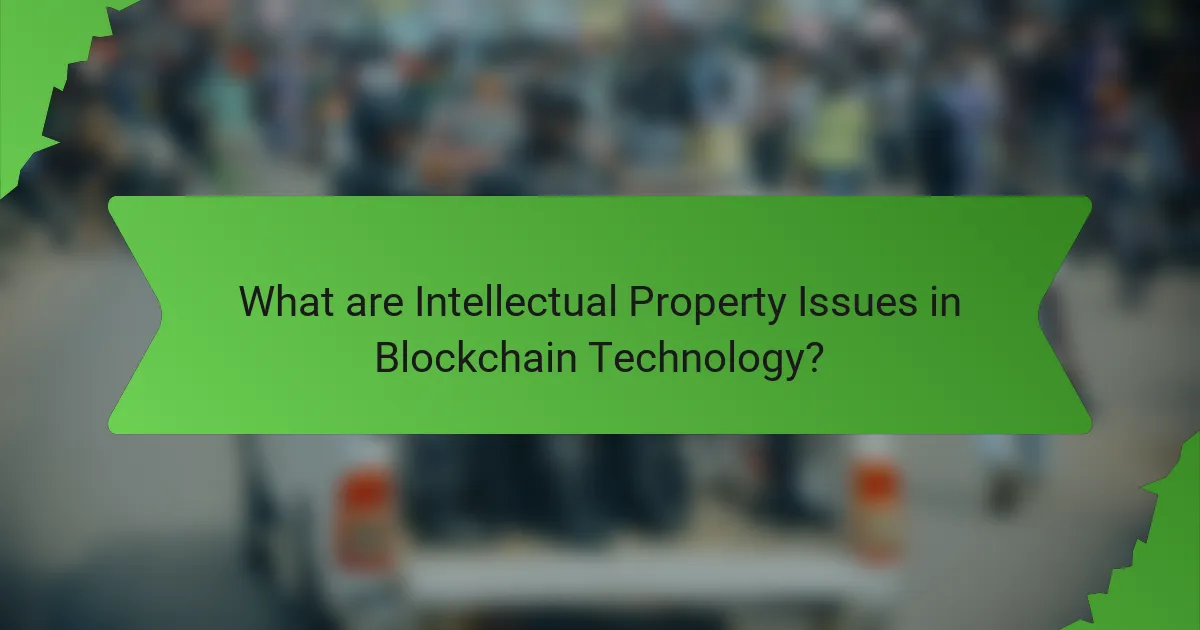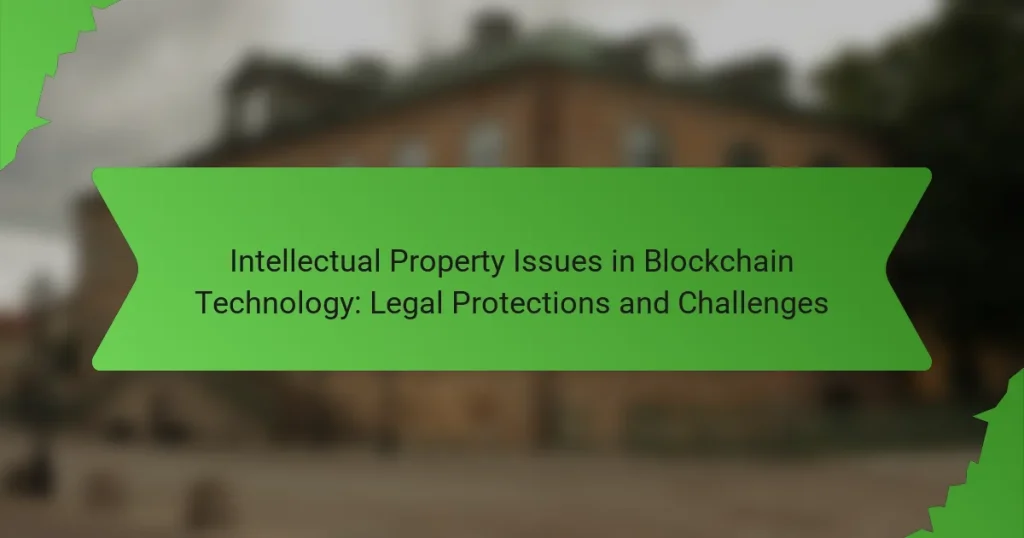Intellectual property (IP) issues in blockchain technology present significant challenges related to copyright, patents, and trademarks. The decentralized nature of blockchain complicates the identification of rights holders and the enforcement of IP rights, leading to potential disputes over ownership and usage. Current legal frameworks often fail to address the unique characteristics of blockchain, resulting in uncertainties for stakeholders. Future trends indicate a shift towards automated IP rights management through smart contracts, enhanced transparency in transactions, and the rise of decentralized platforms for IP registration. These developments suggest a movement towards more efficient and creator-centric systems for managing intellectual property in the blockchain space.

What are Intellectual Property Issues in Blockchain Technology?
Intellectual property issues in blockchain technology involve challenges related to copyright, patents, and trademarks. The decentralized nature of blockchain complicates ownership and rights enforcement. For example, digital assets may be created and shared without clear attribution. This raises concerns about copyright infringement. Additionally, patenting blockchain innovations can be difficult due to the rapid evolution of technology. There may also be conflicts between existing intellectual property laws and blockchain’s unique characteristics. Courts have yet to establish comprehensive legal frameworks for these issues. As a result, stakeholders face uncertainties regarding the protection of their intellectual property rights in blockchain applications.
How does blockchain technology impact intellectual property rights?
Blockchain technology enhances intellectual property rights by providing a decentralized and immutable ledger for ownership records. This technology allows creators to register their works securely and transparently. Each transaction is time-stamped and cannot be altered, ensuring proof of ownership.
Smart contracts automate the enforcement of IP rights, reducing infringement risks. They facilitate licensing agreements without intermediaries, streamlining the process. For example, artists can receive instant payments upon usage of their work.
Additionally, blockchain can help track the distribution of digital assets. This capability combats piracy and unauthorized use. A study by the World Intellectual Property Organization highlights blockchain’s potential to improve IP management and protection.
What types of intellectual property are affected by blockchain technology?
Blockchain technology affects several types of intellectual property, including copyrights, trademarks, patents, and trade secrets. Copyrights are impacted as blockchain can provide a secure method for registering and tracking ownership of creative works. Trademarks can be protected through blockchain by ensuring authenticity and preventing counterfeiting. Patents benefit from blockchain by enabling transparent record-keeping of patent rights and innovations. Trade secrets can be safeguarded using blockchain’s encryption features to restrict access to sensitive information. Each type of intellectual property can leverage blockchain’s inherent capabilities for enhanced protection and verification.
How does blockchain facilitate the protection of intellectual property?
Blockchain facilitates the protection of intellectual property by providing a decentralized and immutable ledger for ownership records. This technology allows creators to register their intellectual property securely. Each entry on the blockchain is time-stamped, establishing a clear timeline of ownership. The decentralized nature of blockchain reduces the risk of unauthorized access or alterations. Smart contracts can automate licensing agreements, ensuring compliance and transparency. Additionally, blockchain enables tracking of usage and distribution, making it easier to identify infringement. According to a 2020 report by the World Intellectual Property Organization, blockchain can enhance the efficiency of IP management and enforcement.
Why are legal protections important in the context of blockchain?
Legal protections are important in the context of blockchain because they provide a framework for enforcing rights and resolving disputes. Blockchain technology often involves complex transactions and digital assets that require clear ownership and usage rights. Without legal protections, users may face challenges in asserting their rights against unauthorized use or theft of digital assets. For instance, intellectual property rights help safeguard innovations and prevent infringement. Legal frameworks also enhance trust and encourage investment in blockchain projects. According to a report by the World Economic Forum, clear legal guidelines can significantly boost the adoption of blockchain technology in various sectors.
What legal frameworks currently exist for intellectual property in blockchain?
Legal frameworks for intellectual property in blockchain include copyright, trademark, and patent laws. These frameworks adapt traditional intellectual property principles to address digital assets. Copyright protects original works, while trademarks safeguard brand identifiers. Patents can cover innovative blockchain technologies and methods. Additionally, some jurisdictions have introduced specific regulations for blockchain-related intellectual property. For instance, the European Union’s Digital Single Market initiative aims to harmonize IP laws across member states. The United States has seen cases like “U.S. Copyright Office v. Aereo,” influencing IP in digital contexts. These legal frameworks help clarify ownership and rights in the blockchain ecosystem.
How do these legal protections vary across different jurisdictions?
Legal protections for intellectual property in blockchain technology vary significantly across jurisdictions. In the United States, legal frameworks like the Digital Millennium Copyright Act (DMCA) provide specific protections for digital content. Meanwhile, the European Union has enacted the General Data Protection Regulation (GDPR), which influences data ownership and privacy rights. Countries like China have developed their own laws, such as the Copyright Law and the Patent Law, which offer distinct protections for blockchain innovations. Additionally, some jurisdictions lack comprehensive regulations, leading to uncertainty for creators and innovators. This disparity creates challenges for businesses operating internationally, as they must navigate differing legal landscapes.

What challenges arise in protecting intellectual property on blockchain?
Challenges in protecting intellectual property on blockchain include issues of ownership, enforcement, and regulation. The decentralized nature of blockchain complicates the identification of rights holders. Intellectual property rights may be difficult to enforce due to the global and anonymous characteristics of blockchain transactions. Additionally, existing legal frameworks often do not adequately address blockchain-specific scenarios. The lack of clarity in intellectual property laws can lead to disputes over ownership and usage rights. Furthermore, the permanence of blockchain records poses challenges in correcting unauthorized use of intellectual property. These complexities highlight the need for updated legal protections tailored to blockchain technology.
How does the decentralized nature of blockchain create legal complications?
The decentralized nature of blockchain creates legal complications primarily due to the lack of a central authority. This absence makes it challenging to enforce regulations and laws consistently. Jurisdiction issues arise because blockchain transactions can cross borders without a defined legal framework. Intellectual property rights become difficult to manage since ownership can be ambiguous in a decentralized environment. Disputes over content ownership may not have clear resolution pathways. Additionally, the anonymity of users complicates accountability for illegal activities. These factors contribute to a complex legal landscape surrounding blockchain technology.
What are the implications of anonymity for intellectual property enforcement?
Anonymity complicates intellectual property enforcement by obscuring the identities of infringers. This lack of transparency hinders the ability to trace and hold individuals accountable. Enforcement agencies face challenges in gathering evidence against anonymous parties. Legal actions become more complex when the infringer’s identity is hidden. Furthermore, anonymity can enable repeat offenses without repercussions. The Digital Millennium Copyright Act (DMCA) illustrates how anonymity can impede takedown requests. Courts often require identifiable information to pursue legal remedies effectively. Thus, anonymity poses significant barriers to effective intellectual property protection and enforcement.
How do smart contracts influence intellectual property rights?
Smart contracts influence intellectual property rights by automating the enforcement of agreements related to intellectual property. They enable creators to set specific terms for usage and distribution of their work. This automation reduces the need for intermediaries, streamlining transactions. Smart contracts can also provide transparent and immutable records of ownership and usage. This enhances the protection of intellectual property rights against infringement. Additionally, they facilitate licensing agreements that can automatically execute payments upon usage. By ensuring that creators receive compensation, smart contracts strengthen the economic rights associated with intellectual property.
What role do international treaties play in blockchain and intellectual property?
International treaties play a crucial role in shaping the legal framework for blockchain and intellectual property. They establish standards for the protection of intellectual property rights across different jurisdictions. Treaties like the TRIPS Agreement set minimum protection levels for copyrights, patents, and trademarks. These agreements help harmonize laws among countries, facilitating international trade and innovation. Blockchain technology raises unique challenges for intellectual property enforcement, including issues of ownership and digital rights management. International treaties can provide guidance on how these challenges should be addressed. For instance, the WIPO Copyright Treaty extends protections to digital formats, which is relevant for blockchain applications. Overall, international treaties are essential for ensuring that intellectual property rights are recognized and enforced in the context of blockchain technology.
Which international agreements are relevant to blockchain technology?
The relevant international agreements to blockchain technology include the General Agreement on Tariffs and Trade (GATT) and the Trade-Related Aspects of Intellectual Property Rights (TRIPS). GATT promotes international trade and addresses barriers that can affect blockchain’s cross-border capabilities. TRIPS sets minimum standards for intellectual property protection, which is crucial for blockchain innovations. Additionally, the Hague Convention on the Law Applicable to Certain Rights in Respect of Securities Held with an Intermediary impacts blockchain by clarifying legal frameworks for digital assets. These agreements collectively influence how blockchain technology interacts with global trade and intellectual property laws.
How do these treaties address the unique challenges posed by blockchain?
Treaties address the unique challenges posed by blockchain by establishing frameworks for intellectual property rights. These frameworks clarify ownership of digital assets created on blockchain networks. They also provide guidelines for the protection of copyrights, patents, and trademarks within decentralized environments. For instance, the World Intellectual Property Organization (WIPO) emphasizes the need for adapting existing laws to accommodate blockchain innovations. Additionally, treaties facilitate international cooperation in enforcement against intellectual property infringement in the blockchain space. This cooperation is crucial due to the borderless nature of blockchain technology. By addressing these legal ambiguities, treaties help foster innovation while protecting creators’ rights in the digital landscape.

What are the future trends in intellectual property and blockchain technology?
Future trends in intellectual property and blockchain technology include increased automation of IP rights management. This trend is driven by smart contracts that facilitate licensing agreements. Enhanced transparency in IP transactions is another trend. Blockchain’s immutable ledger ensures traceability of ownership and usage rights.
The rise of decentralized platforms for IP registration is also notable. These platforms empower creators to secure their rights without intermediaries. Additionally, the integration of AI with blockchain is expected to streamline IP enforcement. AI can analyze data to detect potential infringements more efficiently.
Overall, these trends indicate a shift towards more secure, efficient, and creator-centric IP management systems.
How is the legal landscape evolving for intellectual property in blockchain?
The legal landscape for intellectual property in blockchain is evolving rapidly due to technological advancements. Governments and regulatory bodies are increasingly recognizing the need for updated frameworks. Countries like the United States and the European Union are exploring new legislation to address copyright, patent, and trademark issues related to blockchain. Recent cases have highlighted the challenges of enforcing traditional IP rights in decentralized environments. For instance, the U.S. Copyright Office has started providing guidance on the registration of blockchain-based works. Additionally, the World Intellectual Property Organization (WIPO) is conducting studies on how blockchain can enhance IP protection. These developments indicate a shift towards more adaptive legal frameworks that accommodate the unique characteristics of blockchain technology.
What innovations are being developed to enhance intellectual property protections?
Innovations being developed to enhance intellectual property protections include blockchain technology, smart contracts, and AI-driven monitoring systems. Blockchain provides a decentralized and immutable ledger for recording ownership and transactions, ensuring transparency and traceability. Smart contracts automate licensing agreements and enforce compliance, reducing the risk of infringement. AI-driven monitoring systems analyze online content for potential IP violations, enabling swift action against unauthorized use. These technologies collectively improve the efficiency and effectiveness of IP enforcement. For instance, a 2021 study by the World Intellectual Property Organization highlighted blockchain’s potential to streamline IP registration processes and combat counterfeiting.
What best practices can stakeholders adopt to navigate intellectual property issues in blockchain?
Stakeholders can adopt several best practices to navigate intellectual property issues in blockchain. First, they should conduct thorough IP audits to identify existing rights. This includes assessing patents, copyrights, and trademarks relevant to their blockchain technology. Second, stakeholders should implement clear agreements regarding ownership and usage rights. This can prevent disputes over IP ownership. Third, they must stay informed about evolving regulations and standards in blockchain IP law. This knowledge helps ensure compliance and strategic planning. Fourth, using blockchain technology to register IP rights can enhance protection and provide an immutable record of ownership. Finally, stakeholders should collaborate with legal experts specializing in blockchain and IP law. This collaboration can provide tailored strategies for specific challenges and opportunities in the blockchain landscape.
How can businesses effectively manage their intellectual property in a blockchain environment?
Businesses can effectively manage their intellectual property in a blockchain environment by utilizing smart contracts. Smart contracts automate the enforcement of IP rights, ensuring compliance and reducing infringement risks. They can define ownership, licensing terms, and usage rights directly on the blockchain. This transparency creates a secure and tamper-proof record of IP transactions. Additionally, businesses should register their IP assets on blockchain platforms to enhance visibility and establish proof of ownership. According to a study by the World Intellectual Property Organization, blockchain can streamline IP management and reduce administrative costs. By integrating blockchain technology, businesses can protect their intellectual property more efficiently.
What resources are available for understanding blockchain and intellectual property rights?
Resources for understanding blockchain and intellectual property rights include academic papers, online courses, and legal guidelines. The World Intellectual Property Organization (WIPO) provides extensive resources on IP and blockchain. The Harvard Law School’s Berkman Klein Center offers research papers on the intersection of blockchain technology and intellectual property. Online platforms like Coursera and edX feature courses on blockchain that cover legal implications. Additionally, the European Union Intellectual Property Office (EUIPO) publishes reports on blockchain’s impact on IP rights. These resources collectively offer comprehensive insights into the legal challenges and protections associated with blockchain technology.
Intellectual Property Issues in Blockchain Technology encompass the challenges and legal frameworks surrounding copyright, patents, and trademarks in a decentralized environment. The article examines how blockchain technology enhances IP rights management through secure ownership records and smart contracts, while also addressing the complexities of enforcement and jurisdictional variations. It highlights the implications of anonymity and the evolving legal landscape, including international treaties that shape IP protections. Stakeholders are provided with best practices for navigating these issues, emphasizing the importance of updated legal frameworks and innovative technologies in improving IP management.




